#magnificent century is the inspiration for this post
Text
The events following the end of AC1 to Altaïr’s death in Revelations except it’s an overdramatic historical soap opera feat. slow motion scenes, dramatic music, zoom-ins, internal monologues, and so many fucking transitions
#assassin’s creed#altaïr ibn la'ahad#ac1#magnificent century is the inspiration for this post#yes I know it’s Turkish#and this would be an Arab soap opera but#it keeps the dramatic nature#BRO LIKE THOSE INDIAN SOAP OPERAS THAT ARE SO FUCKING FUNNY BC THEYRE SO DRAMATICALLY EDITED 💀💀#all of that but an events following ac1 soap opera#babblingbrook babbles
13 notes
·
View notes
Text























𝐍𝐎. 𝟗 ❛ 𝐡𝐨𝐭 𝐚𝐧𝐝 𝐟𝐚𝐬𝐭 ❜ | CANARÍS, OCTOBER 1991
❧ 𝐝𝐢𝐫𝐞𝐜𝐭𝐨𝐫𝐲 / 𝐛𝐞𝐠𝐢𝐧𝐧𝐢𝐧𝐠 / 𝐩𝐫𝐞𝐯𝐢𝐨𝐮𝐬 / 𝐧𝐞𝐱𝐭.
In Canarís, something shifted. Arnaut perceived it as subtle, and he struggled to name it when he wondered aloud to Lorraine. He danced around it, grasping for meaning in observations, but there was a simple explanation. In his gut, he felt that people had been happy to see him. Their family arrived at the train station as the work week ended, emerging like generations before them to a crowd of locals eager to greet royalty. German and Abelina were becoming accustomed to the rhythm of life in Uspana. It was cause for optimism that the newborns would grow up without the adjustment pains that the rest of the family faced. Just as well, their birth inspired a deluge of good press. Arnaut quickly learned the public more readily embraced him as a father than as someone capable or even destined to lead them. Yet, at the train station, the tenor of their shouts was different. The questions they asked were different. He embraced them, old women and teenagers and grinning toddlers, and they gazed at him with what struck him as new—changed, even—eyes.
❧ we're back !!!!!!! gonna post the magazine covers separately :^) as a reminder, large text will be below the read-more going forward, for ~readability~
𝐟𝐮𝐥𝐥 𝐬𝐜𝐞𝐧𝐞 & 𝐭𝐫𝐚𝐧𝐬𝐜𝐫𝐢𝐩𝐭 ↓
Such welcomings happened everywhere, but residents of Canarís understood themselves to be reenacting a kind of ceremony when it was their turn. A century after abandoning Canarís, the House of Tecuani remained seemingly divided on where its capital lay. The seat of government was in Nakawe. The ancestral home was in Yaas. Many members preferred in recent decades to live by the sea in Canarís—or to buy second homes, at least. This was where the Hunter went when he descended from the mountains to build the kingdom of Uspana, joining seafaring families whose names were subsumed into the clan they chose to lead them. It was the capital until revolting Uspanians many generations later burned and razed much of it, including the king’s palace. There were no palaces in Canarís anymore. There were still magnificent estates, but everyone politely called them villas or cottages, speaking as if belief alone could render the enduring resplendence quaint and inoffensive.
It was possible the crowd’s warmth felt so palpable because Arnaut had spent the entire train ride stewing in desperation. This vacation was unearned, he had decided. The Crown positioned holidays as indispensable. Beatriz herself set aside a few days each month to feign relaxation away from the capital; Arnaut held fond memories of those childhood getaways spent in Initizara, surrounded by their ever-expanding family. No one much had the stomach for Initizara these days, but the schedule of vacations remained.
Yet, Arnaut felt anxious. Didn’t it teeter on the dangerous edge of presumptuousness—promising to work hard, to change minds, and then sacrificing time to pleasure instead? He wrote the accusatory headlines in his head. More than just knowing their names, he listened to news commentators enough to conjure up imaginary criticisms in their voices. Should I smile? he wondered. Or would that make it worse, looking sour and ungrateful? They would ask what he had to complain about. They would think, ‘I’d lose my job if I ran off to Canarís for a week!’ Disapproval had a face in his mind. It was an older woman who watched daytime television while her grandchildren played nearby. She was a clan mother. She voted. She used a backstrap loom. She had looked into a television camera and insisted with dismay, ‘People don’t change at forty.’
Still, that was the sense he got as he interacted with the crowd. Some wanted to fawn over him. They said beguiling things about how excited they were to see him, how happy they were he had come to Canarís, how they prayed for him. The mood was distinct. These people were not just eager for photographs and stories to brag about; they hadn’t all joined the crowd amassing at the station for want of afternoon plans. For some of them, enough to matter, Arnaut inspired something positive. He wasn’t an unwanted pretender masquerading as their crown prince. His visit meant something to them because, in an undeniable way, he did.
Later, he would finally blurt out to Lorraine, ‘I think they were proud of me—really, who knows why or if it’s true, but I believe they were.’
It wasn’t implausible. Arnaut had been hard at work for months, single-minded in his pursuit of improvement. Managing a crowd with charisma had never been an issue for him, but they were too often overcast by a cloud of suspicion and disappointment. On some level, he understood that the smiling faces and enthusiastic waving spoke for themselves and, in reality, his own insecurities were to blame for any misgivings. It was the litany of surveys and polls that shaped his reality, however. He obsessively watched the news, and his head swam with a flood of data pinpointing all the ways the nation found him lacking. It represented the millions of people who didn’t turn out in hopes of having their hand held by a prince for one brief, fleeting moment. Of course, those millions didn’t closely follow his real work, either—weren’t regular readers of tabloid rags like the National Exchange or newspapers of record like Relay. They responded instinctively to what was in the water. If the politicians at Nakawe Palace and the reporters who circled it and the royal family’s true fans found him lacking, the distaste became unimpeachable truth. It was truth to the faceless millions, and it was truth to him.
Lately, he had begun to feel like there was less blood in the water.
They were joining Martin in Canarís, and the two families spent the time frolicking on the beach and dining under the stars. When they went out onto the water together, Martin confirmed Arnaut’s hunch. He suggested in his characteristic brusque way that Arnaut wasn’t as much of a laughable embarrassment as he had been that spring. Martin's wife was frail and almost a stranger, but she laughed heartily and smacked Arnaut’s arm after teasing out the admission that, yes, he was finally feeling likable. She was kind and likable herself, and her slow but steady decline was one of two dark spots on the vacation.
One morning, Arnaut found Martin out on the deck with remnants of breakfast and pages of print news splayed on the table. He only glance at them long enough to register what they were and remarked, “I thought we weren’t reading the news here,” as he sank down into an open seat.
Martin’s nose was in a copy of the Fiscal Register. He replied without looking up, “Not really news, is it?”
Examining the pages, a series of similar headlines grabbed Arnaut’s attention. He slid one of the papers, reorienting it in his direction, and absorbed the cover story with wide eyes. It wasn’t unusual to see Leonor on the front page of tabloids. She had become an exciting subject, and the loyal pack of photographers that trailed her around Nakawe ensured a steady supply of intriguing, occasionally outrageous, exploitable pictures. Arnaut remembered those days. Or, he remembered something akin to what her life was now, so limitless and delicious as to be out of control, with the crucial distinction that the press felt less hungry in his memories. His bad stories came from trustworthy leaks given to reputable journalists, not from candid photographs that spoke—screamed, really—for themselves. He had also never found himself in the mess Leonor appeared to have fallen into almost overnight. These covers offered grainy but unmistakable pictures of her, and Arnaut didn’t need to believe the sensational headlines and captions to be troubled by what the images suggested.
“Did you see this?” he demanded of Martin, his tone incredulous. He flipped the paper around and pointed at the picture dominating the page.
Martin lowered his paper. “Obviously. These aren’t here to be decorative.”
Slowly, Arnaut blinked. “Is that it?” he asked. “You don’t—what, really, no thoughts? It’s shocking, isn’t it? Does anyone know—they do, they must, but what are we doing?”
He might have continued with this attempt to process the news aloud, but Martin interrupted him. “We’re not doing anything.”
“Aren’t you concerned?”
Martin shrugged. “It’s a little dramatic, huh?”
“Is it?” Arnaut shuffled the papers together and read from them. “‘Princess L’s Big Plunge—Almost,’ ‘“Wanted to End It All,” Friend Says,’ 'Drug-Induced Psychosis? Our Expert Speaks on Page 3—’” Arnaut huffed. “I mean, look!”
“We’d know if it was that serious,” Martin replied, untroubled. “You see her all the time, don’t you? Either you can’t be that surprised or it’s all nonsense. You tell me.”
At this, Arnaut frowned. It was a stretch to say they saw each other that frequently. Leonor’s preference was to behave like coworkers, not like relatives and certainly not like people who had always been bound together by deep love for the same remarkable person. Her hours were erratic at best, but it was difficult to complain when no one else did. The people on their team knew her; she had been gifted their unshakeable trust at birth, it seemed, and he struggled with envy for that. When she jeopardized the infallibility of that trust, she would do something to shore it up—impeccable contributions on the policy front, experience-informed insight in a meeting, effortlessly leveraging valuable connections that Arnaut still bumbled his way through. She was living a double life of sorts, so was the problem that she did it too well?
“Maybe she’s fine,” he ventured, folding his arms on the table. Martin had set aside the Fiscal Register and was looking at the papers Arnaut had reorganized. As he did, Arnaut continued, “You know, she looks thinner, but she seems better? I suppose it seemed inappropriate to comment on that kind of thing—everyone else does, so why would I? Someone would say, if she wasn’t healthy. And, she’s there, she’s present, except for when she’s literally not there, which, frankly, is often, but—” At this, Martin snickered. “Even if she’s not actually—uh, what would you say?”
“A drug addict?” Martin offered, grinning.
Arnaut groaned. “Right, okay. Even if she's not doing that badly, then ... She's going to get in trouble for this. I haven't talked to Mama lately, but—”
Martin sat back in his chair. “Oh,” he said, making a show of the pause in a way Arnaut found obnoxious. “You don’t get it, do you?”
“What?” Arnaut retorted. “Don’t be an asshole.”
“Well!” Martin exclaimed, raising his hands. “Look, it’s a mistake to think that this isn’t ... part of the plan.”
“Plan?”
Looking solemn, Martin nodded. “You know Mama reads the tabloids every day. She’s worse than anyone. I think she likes getting mad, or maybe she just likes the gossip that much—” Arnaut waved a hand, and Martin sniffed. “Anyway, she knows what’s going on. Absolutely. I guarantee she knew about this story before either of us did.”
Their mother was a voracious consumer of lurid slop, Arnaut knew. It was a hobby of hers in the same way other people read literature or advice columns. Copies were delivered nightly, and she read them alongside her stack of briefs and letters. Broadly, she was part of their target audience. Uspana’s gossip rags, especially those with an emphasis on royalty, targeted women of a certain age who had grown up alongside Beatriz, who felt empowered by her unprecedented reign, and who saw themselves as equivalent matriarchs in their own communities. They were gatekeepers. They dispensed advice. They protected order, tradition, and the future itself. In all gossip, they found tools to aid their missions, whether it was identifying local problems or raising new national specters to be exercised from their communities. On a baser level, one that was just as real for Beatriz, witnessing other people’s private messes spilled in public gave them an enjoyable reprieve from cleaning up those that were their responsibilities.
Arnaut nodded. “But ... This is a problem, Martin. It looks terrible for all of us, and Leonor is—she’s official, not someone on the sidelines.”
To Arnaut’s surprise, this elicited a knowing smirk from Martin. He nodded and said, “That’s right. Think about it, okay? I know this isn’t your strong suit, but there’s a logic here. It’s a simple idea. Give someone enough rope, and they’ll hang themselves, eh?” Martin mimed the tug of a noose, sticking his tongue out. Arnaut winced as he asked, “Does that ring a bell?”
It did, but it wasn’t clarifying. Arnaut frowned. “I don’t ... Why would that be helpful?”
Martin shrugged. “Mama’s from the old way. Competition? Neutralize it.”
“What?” Realization dawned on Arnaut as Martin sat staring at him, pleased with himself, and he struggled to beat it back. It was the kind of awareness he didn’t want to have, that would be a burden on his heart, but Martin was determined he have it.
“What? What!” Martin laughed, mocking, before concluding, “It makes you look better. If our little niece is out ruining herself, less people are going to be daydreaming about the alternate universe where she does a Beatriz and—”
Arnaut held up his hands. “Alright, I get it. That’s horrible.”
“That’s Mama,” Martin quipped. “But, you know—”
Perhaps as no coincidence, Lorraine and German appeared in the doorway behind Martin’s shoulder. She offered a greeting, and Martin waved before picking up his paper again. The conversation was over. Arnaut looked up at her with gratitude in his eyes, and German leapt over on cue with a large kite in his hands.
“Can we go?” he asked, looking briefly at his uncle before tugging Arnaut’s hand. “The wind is perfect, and Julian is saying I don’t have the right ‘energy’ for flying kites. I don’t even know what that means. They’re not alive, are they?”
Arnaut chuckled and stood up. “Let’s go find out, huh?”
TRANSCRIPT:
[Crowd clamoring]
ARNAUT | I thought we weren’t reading the news here.
MARTIN | Not really news, is it?
ARNAUT | Did you see this?
MARTIN | Obviously. These aren't here to be decorative.
ARNAUT | Is that it? You don’t—what, really, no thoughts? It’s shocking, isn’t it? Does anyone know—they do, they must, but what are we doing?
MARTIN | We're not doing anything.
ARNAUT | Aren't you concerned?
MARTIN | It's a little dramatic, huh?
ARNAUT | Is it? "Princess L’s Big Plunge—Almost," "'Wanted to End It All,' Friend Says," "Drug-Induced Psychosis? Our Expert Speaks on Page 3—”
ARNAUT | [huffs] I mean, look!
MARTIN | You see her all the time, don't you? Either you can't be that surprised or it's all nonsense. You tell me.
ARNAUT | Maybe she's fine. You know, she looks thinner, but she seems better? I suppose it seemed inappropriate to comment on that kind of thing—everyone else does, so why would I? Someone would say, if she wasn’t healthy. And, she’s there, she’s present, except for when she’s literally not there, which, frankly, is often, but—
[Martin snickers]
ARNAUT | Even if she’s not actually—uh, what would you say?
MARTIN | A drug addict?
ARNAUT | Right, okay. Even if she's not doing that badly, then … She's going to get in trouble for this. I haven't talked to Mama lately, but—
MARTIN | Oh. You don't get it, do you?
ARNAUT | What? Don't be an asshole.
MARTIN | Look, it's a mistake to think that this isn't … part of the plan.
ARNAUT | Plan?
MARTIN | You know Mama reads the tabloids every day. She’s worse than anyone. I think she likes getting mad, or maybe she just likes the gossip that much—Anyway, she knows what’s going on. Absolutely. I guarantee she knew about this story before either of us did.
ARNAUT | But … This is a problem, Martin. It looks terrible for all of us, and Leonor is—she’s official, not someone on the sidelines.
MARTIN | That’s right. Think about it, okay? I know this isn’t your strong suit, but there’s a logic here. It’s a simple idea. Give someone enough rope, and they’ll hang themselves, eh? Does that ring a bell?
ARNAUT | I don't … Why would that be helpful?
MARTIN | Mama's from the old way. Competition? Neutralize it.
ARNAUT | What?
MARTIN | “What? What!” [laughs] It makes you look better. If our little niece is out ruining herself, less people are going to be daydreaming about the alternate universe where she does a Beatriz and—
ARNAUT | I don't … Alright, I get it. That's horrible.
MARTIN | That's Mama. But, you know—
69 notes
·
View notes
Text
5 More Latin Phrases
to try to include in your poem/story (again)
Over the centuries, certain Latin phrases have been used widely enough in English to get included in the dictionary.
Aere Perennius
"More lasting than bronze"
In the final poem in his third book of Odes, Horace boasts that his poetry will outlive any manmade monument:
"Exegi monumentum aere perennius." ("I have made a monument more lasting than bronze.")
Given that his words continue to be used two thousand years later, perhaps he's right.
Caveat Emptor
"Let the buyer beware"
In early Roman law, sales of goods were governed by caveat emptor: buyers were advised to scrutinize the goods before purchase, because sellers had few obligations.
Over time, the imperative of caveat emptor has been softened by warranties, both express and implied.
Caveat has been adopted directly into English, and has a small range of meanings, including "a warning enjoining one from certain acts or practices" and "an explanation to prevent misinterpretation."
Emptor has likewise been taken directly into the English language, although the word is far less common than caveat; it has retained the rather narrow meaning of "buyer, purchaser."
Per Angusta Ad Augusta
"Through difficulties to honors"
These four words have inspired students and soldiers for centuries.
Alternative translations include "through trial to triumph" and "through difficulties to great things."
Post Hoc, Ergo Propter Hoc
"After this, therefore on account of it"
This refers to the logical mistake of claiming that one thing caused another just because it happened first.
For example, the rooster crows and the sun rises - but to argue that the rooster's crowing causes the sun to rise would be post hoc, ergo propter hoc reasoning.
It was Aristotle who laid the groundwork for classifying bad arguments based on logical errors like this one.
Si Monumentum Requiris, Circumspice
"If you seek his monument, look around"
It took 35 years to complete London's magnificent St. Paul's Cathedral.
When its architect, Sir Christopher Wren, died twelve years later in 1723, he was entombed inside, under a simple slab of black marble.
Wren's son placed a dedication nearby, which contains the words "Lector, si monumentum requiris, circumspice" ("Reader, if you seek a monument, look around you").
The phrase is generally used to describe a person's legacy - and can be taken to mean that what we leave behind (including intangible things like relationships) best represents our life.
If any of these phrases make their way into your next poem/story, please tag me, or leave a link in the replies. I would love to read them!
Latin Phrases pt. 1
#writing prompt#writeblr#spilled ink#writers on tumblr#poets on tumblr#literature#poetry#words#lit#writing challenge#latin#langblr#studyblr#dark academia#writing tips#writing inspo#writing ideas#writing inspiration#writing reference#writing resources
108 notes
·
View notes
Note
Hello,
I apologize in advance if you've already answered something like this but my cursory look didn't show anything. I am looking for a game system that has an emphasis on the feeling of a wild west movie while still retaining general fantasy elements from DND. The wild spaces are slowly becoming tamed, increasing technological/magical advancement are pushing disparate communities together, and of course cocky assholes with guns (or a magical equivalent).
Thanks in advance
Theme: Wild West Fantasy
Hello friend, you might want to check out my Fantasy Westerns rec post, to see if anything there fits what you’re looking for. I especially recommend checking out the rec for We Deal In Lead and Clink. For the rest of this post, I try to span a very broad range, so I don't expect everything to stick - but perhaps one or two do!
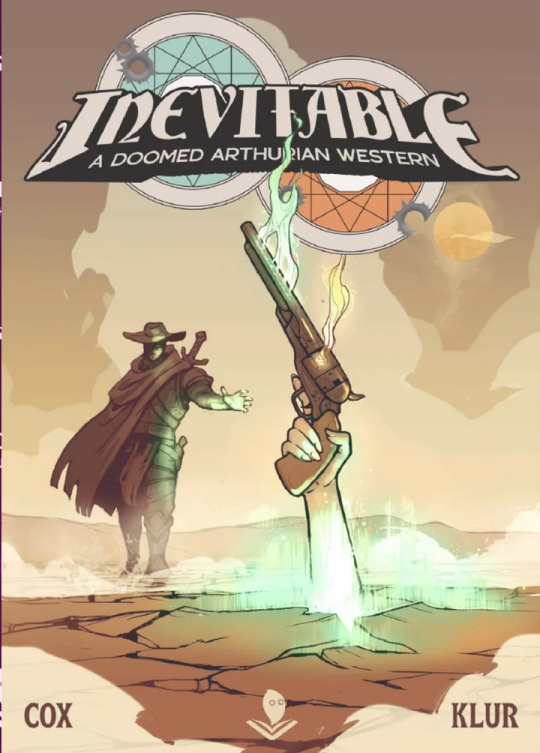
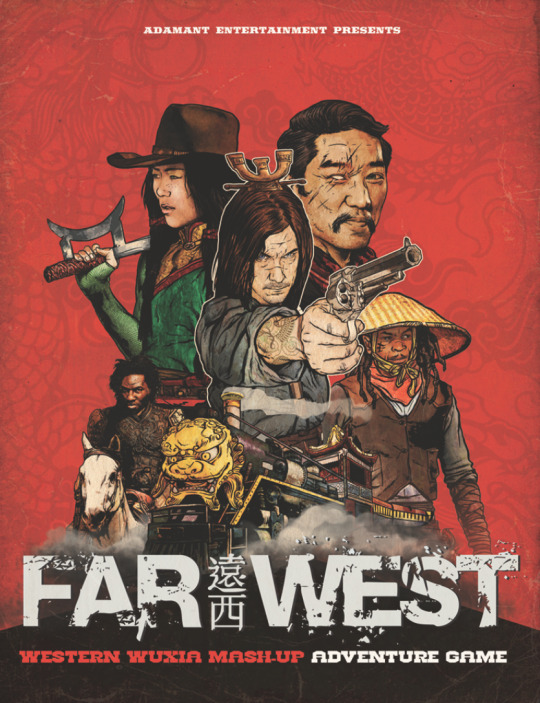
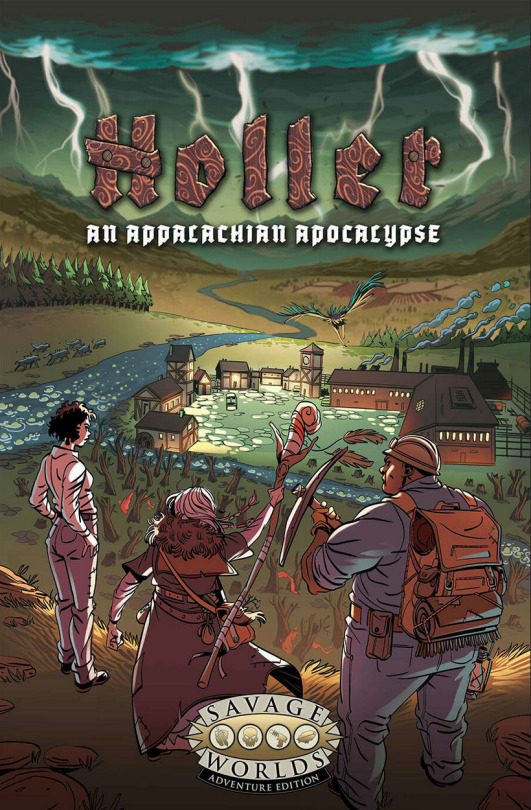
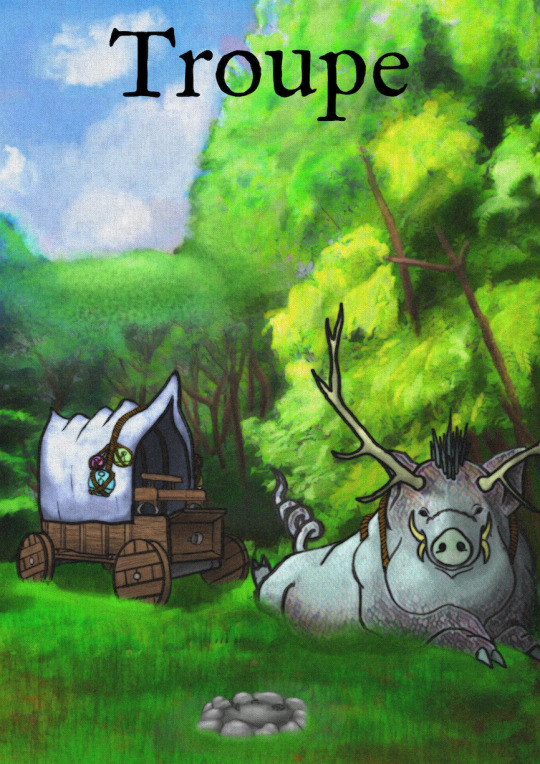

Inevitable, by Soul Muppet Publishing.
Knights and wizards have defended the Kingdom of Myth for centuries. These lands have known peace and prosperity, but soon the kingdom shall be destroyed. The Prophets have declared that your city shall burn and Myth will fall. All those who follow your King shall die. It is INEVITABLE.
But you shall defy fate. Myth will not end while you bear arms.
You will fail, but as long as there are still stories, they will sing of you!
Inevitable is a Arthurian Western roleplaying game for 2-6 players and a GM, where your party of disastrously sad cowboy knights fail to stop the apocalypse. This 284 page book contains all the rules, character creation and the setting for your campaign, thoroughly and evocatively detailing The Barren, the lands surrounding the Kingdom of Myth.
This game might be way you’re looking for: it describes itself as a fantasy kingdom, with western aesthetics. There are wizards, prophets, and rune-carved revolvers. Your reputation in the kingdom is important; it determines how well you can face challenges, and roll pools of d6 on a table of staggered success. If you want a taste before you buy, there’s a Quickstart with some evocative set pieces, a quick overview of the rules, and a quick adventure to run through with a list of pre-generated characters.
Far West, by Adamant Entertainment.
Imagine a fantasy setting that shatters the tropes of Medieval Europe.
Imagine a collision of Spaghetti Westerns and Chinese Wuxia by way of Steampunk.
Imagine a world where gunslingers and kung fu masters face off against Steam Barons and the August Throne.
Imagine fantastic machines powered by the furies comprising the fabric of the universe.
Imagine an endless frontier where wandering heroes fight for righteous causes while secret societies engage in shadow wars.
Imagine…
This game is a combination of Wild Western tropes and Wuxia fantasy. Your characters are wandering heroes, defending the small and helpless against the strong and powerful. I look at this game and I think of movies like The Magnificent Seven. Mechanically, it’s its own system, but it draws heavily from Fate, using positive and negative aspects to boost rolls and spark complications.This game relies on some tropes that require entire table buy-in: I’m not sure how many assumptions the game makes about the cultures it takes inspiration from.
Holler: An Appalachian Apocalypse (Savage Worlds), by Pinnacle Entertainment.
In Holler, the mysterious “Big Boys” own the mines, mills, and logging operations. They rule over every aspect of their workers’ lives—subjecting them to extraordinary dangers on the job and crushing oppression outside of it. The Big Boys have transformed the land of the Holler—rivers bubble with strange chemicals, strip-mined mountains crumble into valleys, and the air is choked with a toxic fog known as the Blight. The flora and fauna of the Holler grow more monstrous by the day. Demons of every description lurk in the forests. Mutant cryptids haunt villages with their strange cries and appetites. Vengeful haints leer from abandoned shacks and lonely cliffs. No one is coming to save the people of Holler.
The goal of the resistance is to build a coalition, to bring together diverse factions—humble workers, roustabouts, mountain men, dirt track racers, cultists, and even strange creatures of myth and legend to raze the works of the Big Boys and drive them from the Holler forever. Holler draws deeply on Appalachian history, mythic folklore, and culture to create a dark fantasy world of apocalypse and vengeance.
This sounds a little more grim and gritty, with cryptids, toxic fog and demons lurking in the forest. It uses the Savage Worlds system, so you’ll have to pick up the codebook to play with it, but the setting is very very fleshed out. This is a little less Wild West and a little more Appalachia, and the setting is a bit more on the horror side than most of the other games on this list, but there’s certainly a lot of wildness out there for you to fight!
TROUPE, by TheOriginalCockatrice.
A game about travel, discovery, and outsiderness, a combination of the best of Old-School and Story Games. Complete with 6 Jobs, including the Ghelf, the Hedge, and the Ogra, and includes a system for holistically coming up with a character from scratch.
The designer describes this game as an exploration of the road; the odd and unknown of the wild, what it means to belong, and what it means to be on the outside. You’re not heroes - you’re entertainers, jokers, healers and bards. There isn’t exactly magic, but there is myth and legend. This is a great game for folks who want plenty of challenges that exist outside of combat. Each character playbook comes with a balance of mechanical elements and descriptive options, and you’ll be rolling 2d6 plus your stat in order to determine success.
I’m not sure how much of a Western this is, but the designer actually hacked this game for BXLLET, a game about gunslingers in the apocalypse, in the zine Bxllet Clip, so it might be worth checking out!
Shotguns & Sorcery, by Full Moon Enterprises.
Welcome to Dragon City, a grim, gritty metropolis ruled over by the Dragon Emperor, with legions of zombies scratching at the city walls by night.
Whether in the streets of Goblintown or the prestigious halls of the Academy of Arcane Apprenticeship, people try to scrape by, make a living, and survive from one day to the next. You, however, are looking for something more than simple survival. And in this city, if you don’t make your own adventure, another adventure is sure to find you.
Shotguns & Sorcery is a fantasy noir game complete with Dragon City Intrigues, roving hoards of undead, and unexplored mountains rife with magical creatures. You’ll see magical staffs alongside light pistols, bows alongside submachine guns, and greatswords alongside canteens, playing cards and a camp stove. The game uses the Cypher System, with an additional character option alongside the three-part character sentence: your race. This includes the signature hafling, elf, dwarf etc.
Games I’ve Recommended in the Past
Knights of the Road, by bordercholly.
67 notes
·
View notes
Text
I’ve been thinking a lot about Tamlin’s family and a lot of the unnamed characters that we get descriptions and bits, but we never get names or characteristics and since I’ve been thinking about writing about Tamlin’s family I thought I would do just that.
Tamlin’s Father - Cernunnos: Associated with nature, fertility, and the wilderness, Cernunnos is a powerful and enigmatic deity often depicted with antlers.
Tamlin’s Mother - Eithne: This name means “kernel” or “grain” in Gaelic and is associated with fertility and the springtime growth of crops.
Tamlin’s Brother - Torin: Derived from the Gaelic word “tor,” meaning “hill,” Torin could represent the rugged landscapes of the Scottish countryside and its connection to the forest.
Tamlin’s Brother - Lachlan: Derived from the Gaelic word “lach,” meaning “lake,” Lachlan could symbolize the interconnectedness of the forest and its surrounding bodies of water.
I think everyone in the fandom knows that Tamlin is based off of Tam Lin who is a character from Scottish folklore. He is the hero of the ballad “Tam Lin,” which tells the story of a young man who is captured by the Queen of the Fairies, but is eventually rescued by his true love, Janet. So these names are inspired by Scottish folklore and Gaelic which refers to the language and cultural traditions of the Gaels, an ethnic group native to Scotland. So this includes elements of Gaelic culture but also draws from other cultural influences. Many Scottish folklore stories and legends have roots in Gaelic mythology and oral tradition, and Gaelic language and culture have played a significant role in shaping Scottish folklore over the centuries.
Now these characters that I’m adding are a personal headcanon on more of Tamlin’s family as I said in a previous post that I felt like he had a sister and @wingsdippedingold said that he definitely had a lot of female cousins which I agree with.
Tamlin’s Sister - Aileana: Derived from the Gaelic word for “green,” Aileana could symbolize the lushness and renewal of springtime landscapes.
Tamlin’s Cousin - Moira/Mòrag: Meaning “great” or “magnificent” in Gaelic, Moira or Mòrag could represent the awe-inspiring beauty of spring and the awakening of nature.
Tamlin’s Cousin - Elspeth: Meaning “God’s promise” in Scottish Gaelic, Elspeth could symbolize the renewal and hope associated with springtime.
Tamlin’s Cousin - Isla: Meaning “island” in Scottish Gaelic, Isla could represent the interconnectedness of land and sea in the natural world.
Tamlin’s Cousin - Lileas: This name is a Scottish variant of Lilias, derived from the Latin word for “lily.” It could symbolize purity, beauty, and the blossoming of flowers in the spring.
Now there are no names specifically opposite to Eithne, which is what I wanted for Tamlin’s aunt and Tamlin’s Mothers sister so I chose a name instead that could serve as complementary figures in Scottish folklore, representing different aspects of femininity, light, and darkness.
Tamlin’s Aunt - Catriona: A Gaelic form of Catherine, Catriona could symbolize grace, elegance, and refinement, contrasting with Eithne’s association with the wild and untamed aspects of nature.
Tamlin’s Uncle - Herne: A ghostly figure associated with the forest and hunting, Herne the Hunter is a mysterious presence in Scottish folklore.
#tell me your thoughts though i would love to see opinions#just thoughts to be honest#acotar#tamlin#tamlin’s father#tamlin’s mother#tamlin’s brothers#family tree#sarah please just give us names#i’m begging at this point#pro tamlin
27 notes
·
View notes
Text
This is not an update to the Comic, but it still has something to do with it !!!
(call it a little gift for the Wish Rewrite and KoW fandom)
Hello my little stars! How are you?
I mentioned in the last post in the series that I would be traveling for a week or two and that's why I wouldn't be working. Well I'm still traveling Lmao.
It's been a lot of fun, I'm visiting my Prince Charming and family, both of whom I haven't been to in a long time. Still, I couldn't stop thinking about KoW and Wish's Concept Arts. Disney sealed the fate of its fan artists by discarding so much good material, now they are embedded in our minds and we will not be able to rest until we see them realized. This is crazy but it's beautiful to see how much these discarded concepts generated creative potential in the fandom.
Because of all this I couldn't help but make some small sketches! And well, I came to show them here. They are not sketches of Comic panels, but they have something to do with it and I will show the photos and explain how.

This first one, very faded, are Magnificent and Amable's clothes (designed by @uva124, for the characters in @annymation's rewrite of Wish "The Kingdom of Wishes"). The drawings that Aled did are very complex, I don't judge her for that, in fact I thank her, she gave beautiful clothes to the centuries-old Disney villains and they are perfect. I really wish I could draw them with all the details, but I will do everything by hand, alone and seeking a minimally professional quality (I want to be a comic artist/book illustrator one day. This comic is my first step Lmao, and I want to do something that conveys the best I can give at the moment), so I need to make some things easier for myself. The costumes are one of those things.
" Better something simple and well done than complex and poorly done." — This is my motto for this Comic and for my life.
The next sketches are related to aesthetics. I've been watching a lot of "Analyzing the Art" videos of some Disney films and I was inspired to adopt some "Disney Style" features in my arts for this comic (not everything obviously, because I don't want to be sued by Disney lmao).
What you'll see next is me trying to mix this influence with my own style in some KoW character sketches.


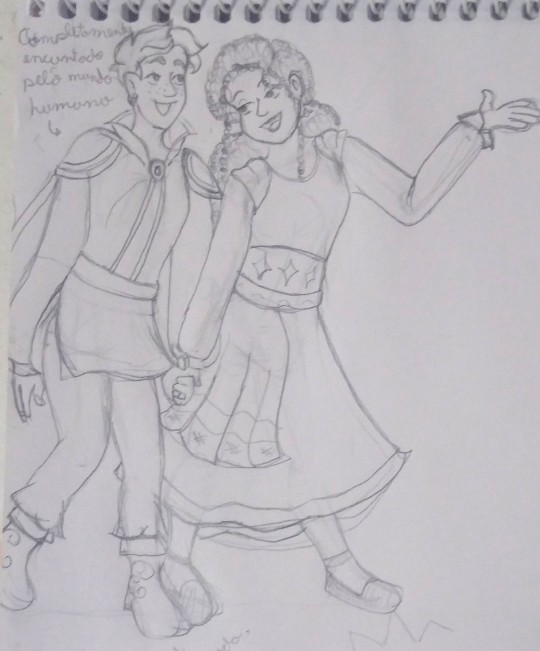
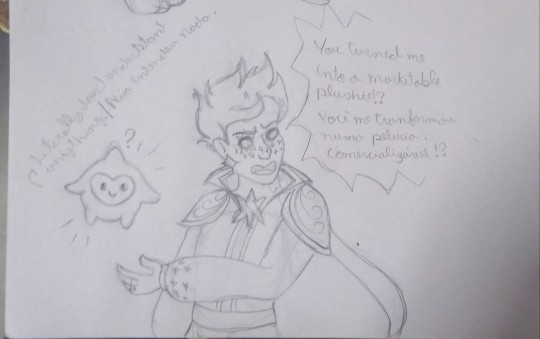
(this last art specifically references a meme in which @rascalentertainments tagged me, Thanks for that, by the way! <3 )

(credits to the artist, I don't know who it is because I was just tagged in this meme and I was busy So I didn't look for more information, but I'll leave the post link and you can check the official credits)
Speaking of aesthetics. Anny received Chiara's aesthetic from someone — the north star, "daughter of Aster", created by his magic at the very end of Anny's fanfic. This Aesthetic inspired me to create an aesthetic for Asha and Aster too and these were the results:


What's your favorite?
Lmao, It took a lot of work to make Aster's. There are almost no things for "starboys" on Pinterest.
I'm leaving this up to you to share as you wish, consider it a gift to the fandom!
Lastly, I want to say that the artistic analysis videos They also inspired me to put together a moodboard for KoW and I'll be leaving it here. Not even Anny and Aled know about this and I can't wait to see their reactions! I wish I could print this painting and leave it on the wall, but unfortunately I don't have a printer T-T.
This moodboard is helping me with the artistic direction of colors, style and is a visual motivation to stay active at work.
I hope you like it too!

That's it for today, it's already midnight in Brazil and I should be sleeping instead of posting crazy things on the internet. I'm going to tag my friends and go to sleep, Lmao.
Kisses full of light and stars!
~ Emy
@wings-of-sapphire @flicklikesstuff @frogcoven88 @chillwildwave @gracebethartacc @gracebethartacc @kstarsarts @oh-shtars Come and get your therapies after the anguish caused by certain publications by Anny!
#kingdom of wishes#wish reimagined#wish rewrite#wish 2023#disney wish#artists on tumblr#asha wish#starboy#starsha#the kingdom of wishes desings#the kingdom of wishes au comic#the kingdom of wishes au#behind the papers?#behind the scenes#aesthetic#scketchbook#scketchs#please write tags for me when reblogging#I am feeling lazy
29 notes
·
View notes
Note
Hi there! I just found this blog and omg I've found my people lol. I just read your response to an ask requesting how one of our yautja boys would react to their human going down on them for the first time, which was incredibly hot and also hilarious, and I had to ask - do you envision the same sort of reaction from a female yautja? Because not to get too into it here in your asks unprompted - but if there's one way this gal wants to go out its with her head between Those Thighs TM
You and I are in the same boat, friend. (Says a creepy voice from the shadows as I rise from the grave with this post lol)
(My take on this with a male yautja can be found here.)
I kinda feel like a female Yautja would be a lot more calm, a lot more logical, and way more permissive from the jump. A Yautja female doesn't have to worry about an appendage being gnawed off, and she certainly doesn't have any perturbation about your oral structure, as dull and unthreatening as it looks. I don't think female-receiving oral is a big thing for Yautja, (though it's far more probable than its male counterpart) but maybe they engage in tongue action from time to time with their own species. I do, however, think that the idea of lips, blunt teeth, and a wider, much smoother tongue would interest a female yautja enough to make her want to try it from the minute the topic is raised...
Mature content below the cut
Terrifying could be a very fitting adjective for your situation for some. A less seasoned human in the fine art of romancing deadly extraterrestrials would probably have bowed out long before now, before a massive, clawed hand could find purchase on the back of your fragile, tiny head.
She's 8 and a half feet of nothing but thew and venom. More muscle than you've ever seen packed onto a curvy frame, with muscular pectorals and the nicest ass and hips you've ever seen. And it's all wrapped in a pretty package of dappled greens and browns, textured skin pulled over the planes of her body in such a right way that it isn't fair.
She's absolutely gorgeous... you know, in her own viscerally terrifying way.
Currently a grunting, growling mess, all teeth and fire-eyes as she writhes beneath you, she's even more alluring. Like a needy predator with deadly claws, she grinds just this side of too hard into your face with a rolling insistence that sparks at your need to provide and please her, wanton enough to inspire a succinct pride within you that you are the source of such a massive, intimidating galactic predator's pleasure.
"Right there." She grits through her teeth, somehow making it sound like a plea and a demand in one. Tree trunk thighs tighten around your head, careful not to pop it like a too-ripe watermelon, and she goes completely still.
Convergent evolution - if such concepts can be applied interplanetarily- is a magnificent thing. Darwin, or what dust is left of him after those centuries past, should be doing backflips in his grave...
In two beats, she's gone, mewling to the stars on the other side of the tempered window in wild bursts of feral pleasure, praying to her brutal gods in a fraternal echo of any human ever to be in her position. Every muscle, previously taut enough that it felt like you could be doing unspeakable things to a boulder, whips along the complete axis of it's motion, spasming in wild bursts of pleasure. As she comes down, panting and growling, she goes limp, only exerting enough energy to haul you up along her frame so you can rest atop her.
On your lips, linger the alien taste of her release, like something not quite familiar enough for a name or a likeness. Gently, she caresses you, tapered claws trailing up and down your back as you rise and fall in time with her massive chest.
"You..." she pants, and you're struck anew with pride at how unraveled you can get her, gruff and unmovable as she usually is. "You are quite skilled with that mouth of yours."
Compliments as such are not unheard of from her but they do fall sparingly and so you soak this one up with a grin. Those shark-like eyes that you've grown to love wander over your face, mapping the topography as if trying to discern for herself what makes your facial structure so pleasurable.
"Consider my ego stroked," you joke, and those eyes swipe up to bore into yours.
"You would like something else stroked." It's not a question, it's a statement she knows to be true and she gives you no time to answer before she rolls and she's on top of you.
Already breathless, you chuckle and bloom beneath her, body spreading under her wandering claws that you know from experience she can use so skillfully...
#This is.... a very late answer#anon if you ever see this I'm sorry I made you wait 15 million years lol#yautja#predator#female yautja
46 notes
·
View notes
Note
My dear and ethereal friend Mother Dolores, ¿What has been your most pleasant and sacred inspiration for the sinister and sacred art that you show every day?. ୁׄ♥︎
Recently I have felt great inspiration by the post mortem and the Rococo artistic movement, although they are totally different styles, I think they make me feel in an angelic way, of ancient and sacred peace.
What I find with your dark and religious art is inner peace as a human being, the tranquility you transmit makes me identify with your sacred scriptures that have been wrapped in your blessed hands. ⛪ ♱
You are a special being that the Virgin Mary has brought into this world to demonstrate that we are angelic beings and that we have been brought into this violent world for one purpose. I love you, may God bless you forever and ever. 👼🏻🫀👼🏻

া♱ Behind the rocks, there is a dead body with unimaginable bruises, filled with words that it explores along with poetry, a movement that revolves around time in human warfare. The only thing that gives strength to my words is the dawn, my beloved Angel Divinidad. My greatest inspiration towards my own art is navigating through the centuries in melancholy and hope for family unity, the antiquated words of a Queen to empower her grand valley of Porcelain Dolls. I feel that the diaries of Gemma Galgani, St. Catherine of Siena, Margaret White, Virgin Queen, Dolores del Rio, and Lupita Ferrer have embraced a huge part of my childhood, and above all, I have been most blessed by their artistic works (performance, mercy, talent, charm, longing, etc...). To any tide that surpasses my creativity, I will always have the authentic company of my natural feelings. Clarity surrealism, although drama will always be in my most holy blessing. I have to feel that angelic strength again, for which I used to kneel in the Catholic Church to save my loved ones with captivating words. My other inspiration is the majestic art of Kaho Honey, Élisabeth Vigée Le Brun, Brooks Ginnan, Suehiro Maruo, and my dearest @genesisfawn (I suggest with utmost pleasure that everyone who adores me, needs to follow this wonderful dark artist of Kingdom's Fawn). The entire audience should know about the question you just asked me about myself, and with the utmost knowledge from my mind, I replied with these beautiful words.
Despite other interests that bless my words, I am glad that you have found that passionate quality with Rococo style and the untold stories of the Post-Mortem. It makes a great impact to remember silent film. I am happy for you that you have found a strong bond of inspiration towards your style. I am grateful for your divine friendship, enchanting beauty.
Truly, I deeply value the sentiments you have bestowed upon my artistic endeavors, encompassing my crafted works of art, poetry, and intricately woven tales. The magnificence of your expression is akin to the celestial radiance that graces the most sacred twilight, heralding the rebirth of crimson-hued roses. From the core of my being, I hold profound gratitude for your profound appreciation. ♱া
O sweet Angel, I come forth with a question, solely directed to you... What have I done for you to articulate my persona in such a mesmerizing way?
۬ ۬ ۬ ۬ ۬ ۬ ۬ ۬ ۬ ۬ ۬ ۬ ۬ ۬ ۬ ۬ ۬ ۬ ۬ ۬ ۬ ۬ ۬ ۬ ۬ ۬ ۬ ۬ ۬ ۬ ۬ ۬ ۬ ۬ ۬ ۬ ۬ ۬ ۬ ۬ ۬ ۬ ۬ ۬ ۬ ۬ ۬ ۬ ۬ ۬ ۬ ۬ ۬ ۬ ۬ ۬ ۬ ۬ ۬ ۬ ۬ ۬ ۬ ۬ ۬ ۬ ۬ ۬ ۬ ۬ ۬ ۬ ۬ ۬ ۬ ۬ ۬ ۬ ۬ ۬ ۬ ۬ ۬ ۬ ۬ ۬ ۬ ۬ ۬ ۬ ۬ ۬ ۬ ۬ ۬
Espero que termines este mes bendito de la Virgen María con un fuerte abrazo fuerte de ángeles verdaderos.
"No permitas que te turbe el pasado, déjalo todo en el Sacratísimo Corazón de Jesús y vuelve a comenzar con alegría." – St. Teresa de Calcutta
7 notes
·
View notes
Text
Counting Down to Hanukkah: How Many Candles Go on a Menorah?
New Post has been published on https://votivecandleholder.com/candle-decoration/counting-down-to-hanukkah-how-many-candles-go-on-a-menorah
Counting Down to Hanukkah: How Many Candles Go on a Menorah?
The menorah is a symbol of Judaism, and it has been an important part of the Jewish faith for centuries. At Hanukkah, it is customary to light a nine-branched menorah, known as a Chanukiah or Hanukkiah. The candles on the menorah have special meanings and importance, so let’s take a look at how many candles are typically used on a menorah.
Table of Contents
1 The Meaning Behind the Candles
1.1 Hanukkah candle holders
1.2 Menorah candle holders
2 The History of the Menorah
2.1 Jewish candle stick holders
3 How Many Candles Are Used for Ceremonial Purposes?
4 How Many Candles Are Used for Decorative Purposes?
4.1 Brass menorah candle holders
The Meaning Behind the Candles
The number of candles used on a menorah is significant because each candle has its own purpose and meaning. On the left side of the menorah are three candles that represent God’s attributes — power (mighty strength), wisdom (divine understanding) and mercy (mercy, compassion).
On the right side are four additional candles that represent human qualities — joy (happiness and delight), honor (respect and esteem), glory (splendor and magnificence) and peace (tranquillity). The ninth candle in the center is called the “shamash” or servant candle which is used to light all other eight candles.
Hanukkah candle holders
The number nine holds a special significance in Judaism, as it symbolizes divine completeness. In other words, it is believed that God has perfect control over all aspects of one’s life with nine being the ultimate number for perfection.
This is why there are eight candles on a menorah plus one extra—the Shamash—which stands for “servant.” The Shamash is lit first and then used to light each of the other candles, thus signifying that God comes before all else.
Menorah candle holders
Each candle also has its own meaning and purpose on the menorah. The first candle represents creation, while the second through seventh represent redemption from slavery in Egypt. The eighth represents freedom from oppression and persecution, while the ninth—the Shamash—represents peace and hope for a brighter future.
Together, these nine candles act as both a reminder of past events and an inspiration for striving towards greater peace and understanding among people today.
The History of the Menorah
The Menorah is an eight-branched candelabrum used as part of Jewish ceremonies and rituals. It is based on a gold lampstand that was used in the Tabernacle in Jerusalem during biblical times.
Jewish candle stick holders
Today, it is often used to celebrate Hanukkah, a festival that commemorates the rededication of the Holy Temple in Jerusalem after its desecration by Antiochus IV Epiphanes. During Hanukkah, Jews light one candle each night for eight days to symbolize miraculous oil that lasted for 8 days when rededicating the temple.
How Many Candles Are Used for Ceremonial Purposes?
When celebrating Hanukkah, a traditional Menorah consists of nine branches —eight branches with candles representing each day of Hanukkah plus an additional branch called the shamash (servant) candle which is used to light each night’s candles—so nine total candles are lit every night of Hanukkah. This type of menorah is usually made out of metal or brass.
How Many Candles Are Used for Decorative Purposes?
For decorative purposes, some people choose to use seven-candle menorahs instead of nine-candle ones for their homes or businesses but still follow the same pattern as traditional Hanukkah practice with seven nights requiring seven different colored candles.
Brass menorah candle holders
These types of menorahs are often made from glass or wood and can come in various shapes and sizes depending on personal preference and budget constraints. There are also electric versions available if you don’t want to deal with wax!
Finally
The nine candles on a menorah have been part of Jewish tradition for centuries. Each candle has its own unique symbolism and meaning, which serves to remind us that our history should never be forgotten nor taken lightly. By taking time to understand each candle’s significance, we can learn important lessons about ourselves and how we can continue striving towards better days ahead. So take some time this Hanukkah season to reflect upon the powerful message behind these nine candles. Use them as an opportunity to grow spiritually, emotionally, and mentally!
4 notes
·
View notes
Text
Exploring the Natural Beauty of Ecuador: Memorable Trips to Ecuador
Ecuador, a hidden gem in South America, offers an array of experiences for the avid traveller. With its diverse landscapes, rich cultural heritage, and friendly locals, Ecuador has become a must-visit destination for those seeking adventure, culture, and nature. In this blog post, we will delve into some unforgettable trips to Ecuador, showcasing its breathtaking beauty and unique attractions.
Discovering Ecuador's Breathtaking Landscapes
Ecuador is renowned for its stunning landscapes, ranging from the lush Amazon rainforest to the towering Andes Mountains. One of the most remarkable trips to Ecuador begins with an exploration of the Amazon basin, where you'll have the chance to witness the incredible biodiversity that thrives within this dense jungle. Guided tours through the jungle will introduce you to exotic wildlife, including vibrant macaws, playful monkeys, and elusive jaguars.
Venturing further inland, the Andes Mountains offer a completely different experience. The picturesque town of Banos, nestled in the shadow of the Tungurahua volcano, is a perfect starting point for hikers and adventure seekers. Hiking trails crisscross the area, leading you to pristine waterfalls and natural hot springs, where you can relax and soak in the breathtaking scenery.
Immerse Yourself in Ecuadorian Culture
No trip to Ecuador is complete without experiencing its rich cultural heritage. Quito, the capital city, is a UNESCO World Heritage site and a hub of colonial architecture. Strolling through the historic Old Town, you'll encounter centuries-old churches, charming plazas, and colourful markets. Don't forget to sample Ecuador's famous cuisine, which includes delicious dishes like ceviche, llapingachos, and empanadas.
For a deeper dive into Ecuadorian culture, consider a visit to Otavalo, a town renowned for its indigenous markets. Here, you can shop for traditional textiles, artisanal crafts, and vibrant woven goods while interacting with the welcoming local communities.
Galapagos Islands: A Natural Wonder
No discussion of trips to Ecuador would be complete without mentioning the Galapagos Islands. Located 600 miles off the coast of Ecuador, this remote archipelago is a haven for wildlife enthusiasts and nature lovers. Charles Darwin's visit to the Galapagos inspired his theory of evolution, and to this day, the islands remain a living laboratory of evolution.
A cruise through the Galapagos allows you to witness unique species such as giant tortoises, marine iguanas, and blue-footed boobies in their natural habitat. Snorkelling in crystal-clear waters alongside playful sea lions and colourful fish is an experience you'll cherish forever.
Sustainable Tourism in Ecuador
As you embark on your trips to Ecuador, it's essential to prioritise sustainable tourism. Ecuador is committed to preserving its natural beauty and cultural heritage. Many tour operators and accommodations in the country focus on eco-friendly practices and support local communities.
By choosing eco-conscious tour providers and respecting the environment and local customs, you can contribute to the preservation of this magnificent destination for future generations.
Wrapping Up
Trips to Ecuador offer a unique blend of natural beauty, cultural immersion, and unforgettable experiences. From the diverse landscapes of the Amazon and the Andes to the cultural richness of Quito and Otavalo, and the pristine wonder of the Galapagos Islands, Ecuador has something to offer every traveler.
When planning your next adventure, consider Ecuador as your destination. Whether you're an avid nature enthusiast, a history buff, or simply seeking a new cultural experience, Ecuador has it all. Start your journey to this captivating South American nation, and you'll create memories to last a lifetime. Come and discover the beauty of Ecuador for yourself!
6 notes
·
View notes
Text
Unit 9 Blog Post
Interpet (through this blog) the most amazing thing you know about nature – get us excited. This is your blog – your audience isn’t in the field with you so bring the field to your armchair reader.
There are so many concepts of nature that I can speak upon that amaze me, such as bioluminesence, the beauty of the northern lights, and the captivating diversity in nature. However, for this week’s blog, I wanted to take a different approach and reflect upon the beauty that humans have provided within nature. Every piece tells a fascinating story; a collection can form a narrative that spans centuries, continents, and cultures.
I find it astounding to look back at the technical wonders that have shaped history, especially as we stand on the shoulders of innovation in the 21st century. When the world's wonders, like the Great Wall of China, the Pyramids of Giza, and the Colosseum, were built, they were engineering marvels. Fast forward to the present, and we are surrounded by a brand new category of wonder: the digital world.
I believe that a lot of the reason we are able to look back and appreciate our history is due to technology. It makes it so convenient for all of us to enhance our knowledge on a topic or concept that we find interesting. It is also worth noting that technology can aid in the transmission of interpretive messages at sites, allowing more visitors to learn about the location (Beck et al. 2018, p. 465). For example, when my family and I went to Los Angeles, we visited the Griffith Observatory (same planetarium seen in ‘La La Land’!). During this visit, we watched a show at the Dome at the planetarium that used the Zeiss Star Projector. The live show we watched was ‘Signs of Life’ which uncovered what it took to put life in the universe. I was truly captivated, along with the audience, by the magnificence of technology and how it can be used to interpret aspects of our history.
In the modern era, prominent technological wonders include the Hubble Space Telescope, the International Space Station, and Mars rovers. These innovative technologies have allowed for explanations of many mysteries in space as well as discoveries. Furthermore, the Hubble Space Telescope has provided us with countless stunning photos of space exploration and the beauty that exists within our solar system—a universe that will never cease to amaze me.
However, among these technological wonders, it is important not to forget the wonders that breathe history—true testaments to human ingenuity and ambition. Each structure within nature holds a unique place in history, leaving a persistent mark on the world (Beck et al. 2018, p. 329). As an Egyptian, it only feels fitting for me to speak of the brilliance of the pyramids of Giza. This is the only one of the Ancient Wonders of the World to survive largely intact today, along with its intricate details and massive scale. Though it remains a mystery how the ancient Egyptians built the pyramids without modern technology, it sparks many theories on how exactly they were created. Nevertheless, it’s inspiring how these architectural marvels, whether ancient or modern, captivate tourists with their awe-inspiring designs and historical significance.
I hope you all find this as interesting as I do, we're embedded within nature and that includes the history that precedes us and continues to evolve. It is also fascinating to me personally how technology and the human creations embedded within nature can strive for many diverse interpretations!
I have provided some images taken from the Hubble Space telescope below :)



References
Beck, L., Cable, T.T., & Knudson, D.M. (2018). Interpreting Cultural and Natural Heritage For a Better World. Sagamore-Venture Publishing.
2 notes
·
View notes
Text

City of Holbore:
History:
Nestled amidst rolling hills and lush greenery, the city of Holbore bore witness to a history rich in trade and diplomacy. Established as a trading post centuries ago, Holbore grew into a thriving city-state, known for its strategic location along the ancient trade routes that crisscrossed the region. Its history was marked by peaceful negotiations, fostering alliances with neighboring kingdoms, and contributing to the stability of the surrounding lands.
Arts:
Holbore was a haven for artists and scholars, its streets bustling with creativity and intellectual discourse. The city's theaters showcased elaborate plays and intricate dances, captivating audiences with tales of love and valor. Renowned artists and musicians called Holbore home, their works adorning galleries and concert halls, making the city a cultural hub where artistic expression knew no bounds.
Famous People:
Holbore boasted a wealth of talented individuals, including the legendary playwright, Elara Montrose, whose iconic tragedies stirred the hearts of audiences far and wide. Scholars like Professor Leontius, renowned for his expertise in ancient texts, found sanctuary within the city's esteemed academies, furthering the pursuit of knowledge.
Castle Holbore:
At the heart of the city stood Castle Holbore, a magnificent structure of weathered stone and graceful arches. With towers that stretched towards the sky and walls adorned with intricate carvings, the castle served as a testament to the city's enduring legacy. Within its halls, diplomats and nobles convened, shaping the city's fate and fostering relationships that strengthened Holbore's influence.
Food:
Holborean cuisine was a delectable blend of flavors, influenced by the bounties of both land and sea. Fresh seafood from the nearby coast, seasoned with aromatic herbs and spices, graced the tables of Holbore's finest restaurants. Local specialties, such as roasted lamb infused with fragrant rosemary and honey-glazed fruits, tantalized the taste buds, creating a culinary experience that reflected the city's diverse culture.
Major Events in Holbore's History:
Holbore's history was punctuated by significant events, including the signing of the Treaty of Veridia, a landmark agreement that established peaceful trade routes with neighboring kingdoms, fostering an era of prosperity and cooperation. The city also celebrated the Festival of Illuminations, an annual event where the streets were adorned with colorful lanterns, illuminating the night sky in a dazzling display of unity and joy.
Major Exports and Imports:
Holbore was renowned for its fine textiles, woven from the softest silks and embroidered with intricate designs, coveted by royalty and nobility alike. Exotic spices, rare gemstones, and fine wines were among the city's imports, enhancing the lives of its citizens and further enriching the local culture.
Beautiful Sights:
Among the city's many beautiful sights stood the illustrious Fountain of Serenity, a breathtaking marble structure adorned with delicate sculptures depicting legendary figures from Holbore's folklore. The fountain's cascading waters, reflecting the golden hues of the setting sun, created a serene atmosphere, drawing both locals and travelers to its tranquil embrace. It was said that those who visited the Fountain of Serenity found solace and inspiration, making it a cherished symbol of the city's enduring spirit.

Welcome to the transformed city of Holbore, now known as Idgo Dol, where the Orcs have left an indelible mark on both its landscape and culture. This once-thriving city, now home to 40,000 Orcs and 11,000 Farfield thralls, bears the scars of conquest and is ruled by an iron fist.
City Transformation:
Idgo Dol stands as a testament to Orcish dominance. The city's architecture has been reshaped into crude, imposing structures adorned with the symbols of the Orcish Warlord. The once-bustling marketplaces are now dominated by Orcish merchants, dealing in weapons, armor, and enslaved thralls.
Orcish Rule:
The city is governed by the fearsome Orcish Warlord, Gronak Skullcrusher. Under his rule, Idgo Dol is a militarized fortress, with Orcish warriors patrolling the streets, ensuring order through intimidation and violence. Farfield thralls are subjected to harsh labor, toiling in mines, farms, and forges under brutal conditions.
Castle Holbore:
Once the seat of Holbore's leadership, Castle Holbore has been renamed Castle Doomspire, serving as Gronak's stronghold and the epicenter of his rule. Its towers loom over the city, symbolizing the might of the Orcish Warlord.
Exports and Imports:
Idgo Dol exports weapons, armor, and magical artifacts crafted by skilled Orcish blacksmiths. These goods are traded with neighboring Orcish strongholds and dark markets. The city imports rare materials, precious gems, and slaves for labor from distant realms.
Orcish Sights:
In the central square, a grotesque statue of the Orcish god MOG stands as the focal point of Orcish devotion. MOG is depicted as a fierce warrior, his massive form covered in blood and wielding a massive axe. Orcs gather here to offer sacrifices, both thralls and captured enemies, as part of their annual ritual in honor of MOG.
Devotion to MOG:
Gronak Skullcrusher is an unwavering devotee of MOG, leading the city with a singular focus on the god of war and blood. The annual ritual, known as the Bloodmoon Festival, involves gruesome sacrifices to appease MOG and gain his favor for the coming year. The city is filled with the sounds of drums and chants during this dark celebration, as thralls are offered to the Orcish god.
Holbore's Legacy:
A somber structure known as the Holbore Memorial stands on the outskirts of the city, commemorating the fallen defenders of Holbore. The memorial serves as a reminder of the city's tragic past and the price paid for resisting Orcish conquest.
Idgo Dol stands as a dark reflection of its former self, a city reshaped by the brutal rule of Gronak Skullcrusher and the Orcish devotion to the god MOG. The once-thriving Holbore has become a place of fear, oppression, and annual ritual sacrifices in the name of Orcish supremacy.
Exterior of Castle Doomspire:
Castle Doomspire, once known as Castle Holbore, stands as a menacing fortress at the heart of Idgo Dol. The exterior reflects the brutal aesthetic of Orcish architecture. Massive stone walls, stained with the marks of battle, surround the castle, rising to formidable heights. Crude spikes and dark banners bearing the emblem of the Orcish Warlord, Gronak Skullcrusher, adorn the battlements. The once-grand entrance has been replaced with a massive iron gate, adorned with the skulls of fallen enemies, a grim testament to the fortress's current occupants.
Towering turrets pierce the skyline, each topped with jagged peaks that evoke a sense of foreboding. The castle's exterior is devoid of the once-lush gardens and decorative elements, replaced by functional structures dedicated to the military and administrative functions of Orcish rule. The overall impression is one of militaristic dominance, a fortress that exudes an air of oppression over the city.
Interior of Castle Doomspire:
The interior of Castle Doomspire is a stark contrast to its former grandeur. The once-elegant halls and chambers have been transformed to suit the brutal needs of Orcish rulership. Dark stone corridors echo with the sounds of heavy footsteps and the clanking of armor as Orcish guards patrol the halls.
The throne room, once a place of diplomacy and governance, is now a cavernous chamber dominated by a massive, crude throne. Gronak Skullcrusher sits upon it, surrounded by the symbols of his power and conquests. The walls are adorned with trophies – weapons, banners, and grisly reminders of battles won.
The castle's dungeons, previously used for the imprisonment of criminals, now house thralls and prisoners of war. The air is heavy with the stench of sweat and despair as captives toil under the watchful eyes of Orcish overseers.
The chambers that were once reserved for the city's rulers have been repurposed as war rooms and planning chambers. Maps of the surrounding territories cover tables, displaying the Orcish ambition to expand their influence.
While Castle Doomspire's interior may lack the refinement and elegance it once possessed, it radiates an undeniable aura of power. The atmosphere within is one of cold, calculated authority, a reflection of the Orcish rule that now governs Idgo Dol from this formidable stronghold.
2 notes
·
View notes
Text
"Demons", Gods, and In-betweens in the Series: Love and Redemption (Part 3)
Part 1
Part 2
Today’s post will refer mostly to 山海经, the Classic of Mountains and Seas which is composed from between 4th and 5th century BC.

The Classic is supposedly collections of verbal descriptions of ancient drawing on bones, walls and bronze plates that had mostly been lost today. Those drawing accompanied the original versions of the Classic. Historical records show that at least one prominent Jin dynasty(265~420) poet enjoyed browsing those “mountains and seas pictures” as a pastime, and there were some effort to print and republish such drawings(unclear how close to original) in Tang dynasty(618~970), but those are also lost to today. The verbal descriptions were probably widely circulated during the warring states period(476~221 BC) and were sorted in categories we see today much later than its first circulation. So this book recounts the very early imaginations and worldviews of ancient Chinese before all those later more formulated cultural traditions took hold. And some of the most magnificent mythological tales of China are recorded in the Classic of Mountains and Seas.
1. 昆仑山 Mount Kunlun
Record in 山海经·大荒南经The Classic: The Great Wilderness South
Perhaps one of the most important mountain in Chinese mythology, Mount Kunlun is said to be the dwelling place of the gods and immortals. Its mythical origin dated back to the Warring States Period (475-221 BCE). Many new religious or mythical elements had been added to the concept of Kunlun continuously in the ages after, which I’m not gonna touch upon. There is a real-world Kunlun mountain but I don’t know how closely it relates to the mythological Kunlun mountain. I’ll simply include what’s described in the Classic, since it seemed to be a primary inspiration for LnD and that the Classics was written roughly at the same time the Kunlun mythology is said to start.
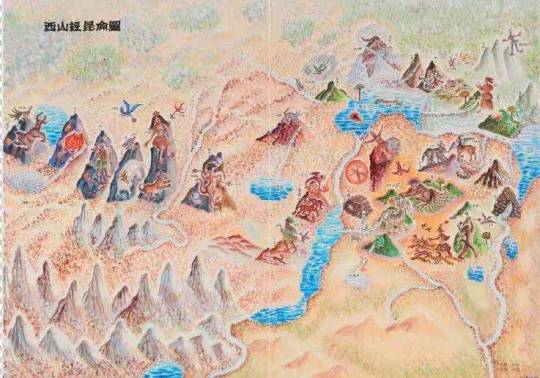
Unlike the usual short entries, Mount Kunlun is actually described with quite a lot of details in the Classic. There are many mythical plants, beasts, locations, immortals and gods depicted in one long entry, which also includes the Immortal Tree mentioned in part 2. It is said “Within the surrounding seas, in the north-west resides the Mountain Kunlun, which is the mortal capital of the heavenly emperor. The Mountain Kunlun is around 800-Li wide, 1000-Ren high(extremely huge). There is a tree-like rice on the top of the mountain, around 5-Xun high and takes five people to hug it.” “Many gods reside there. At the 8-edges rock, by bank of red river, only those who have the capability of (hero king) Yi can manage to climb those mountains and rocks.” “To the north of Kaiming Beast there are…, immortal tree, …”

The way Mount Kunlun is depicted in the show is pretty accurate to the words of the Classic, especially the fun mini-adventure Xuanji and Sifeng’s group of friends took on: they crossed a river, defeated the 6 Wu-shamans(see below), climbed the dangerous cliff, passed the Kaiming Beast(see below) and reached the place where the gods and the heavenly emperor reside.
2. 开明兽Kaimimg Beast
Record in 山海经·大荒南经(same as above)
“At each direction (of Mount Kunlun) there are 9 gates. The gates are guarded by Kaiming Beast.” “The Kaiming Beast’s body resembles tiger and it has 9 heads, all with human faces, standing on Mount Kunlun facing East.” Kaiming开明 means “open”(开), “light, bright”(明), which consists of the symbols for sun日 and moon月.

You can see the Kaiming Beast in the show looks exactly like the depiction in the Classic. The modern meaning of Kaimimg is ‘open to enlightenment and progress.’ It’s interesting how this Kaiming Beast that guards the Kaiming Gate, has a character that isn’t exactly the most noble or bright, but it’s exactly that it does allow the protagonists pass the gate to open rather easily, that led to their progress in their adventure, interestingly.

3. 巫x6, the 6 Wu-Shaman
Record in 山海经·大荒南经(same as above), Guoyu or Discourses of the States (4th century BC)
“To the east of the Kaiming Beast there are Wu Peng, Wu Di, Wu Yang, Wu Lv, Wu Fan Wu Xiang…” Those six Wu were surrounding a corpse and holding immortal drugs in their hand, but what exactly were they doing I’m unable to understand. Maybe they were trying to revive it?

The show has the six Wu-shamans appearing briefly just to be defeated by the group of friends, and they seem to be mostly men. There isn’t much to be said there so let’s take a look at what is Wu-shaman instead.
Wu-shamans were mostly ancient Chinese spirit-mediums and diviner that oversee proto-religious functions and might also be healers. It was said the character巫 represents dancing figure or figures. About the Wu-Shamans, here are some direct quotes from Wikipedia: “The glyph ancestral to modern 巫 is first recorded in bronze script, where it could refer to shamans or sorcerers of either sex. …By the late Zhou Dynasty (4th to 3rd centuries BCE), wu referred mostly to female shamans or "sorceresses", while male sorcerers were named xi 覡"male shaman; sorcerer", first attested in the Guoyu or Discourses of the States (4th century BCE).”
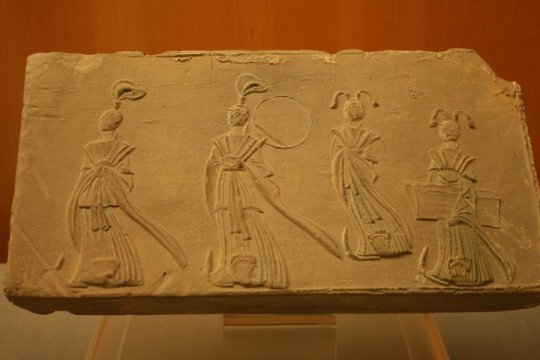
There is said to be a link between Confucius sexism and excluding women from spiritual rituals that was in high regard that took hold when Confucianism started to spread and be selected as the national ‘religion’ by the ruling classes of the time. This is not surprising as we can see women were often excluded from powers structures, especially starting from spiritual positions, in different cultures around the world. This often accompanied especially demonization of sexual desires and freedom.
4. 不周山 Mount Buzhou
Record in 山海经·大荒西经The Classic: The Great Wilderness West, Various other sources in same period and later Han Dynasty(202 BC to 220 AD).
The Classics mentioned “out of the North-west sea, at a corner of the Great Wilderness is a mountain what’s not closed, the name is Buzhou…” The Chinese characters 不周 means ‘un-whole’ or ‘not-revolving.’ In other sources of the same period, Mount Buzhou was said to be a pillar of heaven that was hitted by some angry water god Gonggong, breaking the the mountain and causing the great flood. Whether the name 不周 resulted from that is unclear. According to other sources in Han dynasty Mount Buzhou is to the north-west of Mount Kunlun, and is very cold and always covered by snow. It is said to be the way from the mortal world to directly reach heaven, but normal people could not withstand its hash environment.

In our show Mount Buzhou is also located in a snowy landscape and mortals cannot enter it without help. The merman doc Tingnu created some special magical candles that allowed our protagonists to enter Mount Buzhou. Buzhou mountain seems to be in a difficult realm and its entrance was between two peaks, which is accurate to the text in the Classic, ‘mountain that was not closed.’ The actual mountain area is depicted as a sad devastated land the devils and demons kinds used to reside in. Tianxu Sect set up its main branch there. It also contains the door to the Burning City and holds the hidden opening to the devil’s realm.
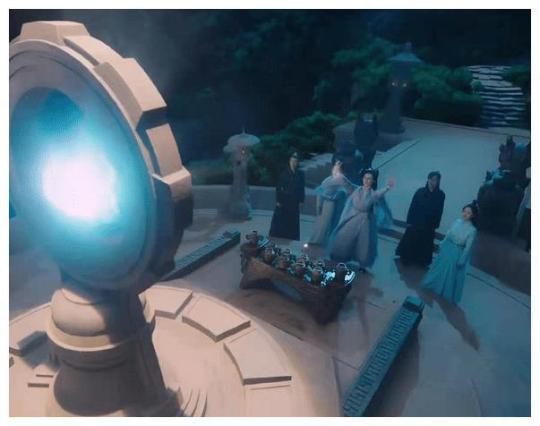
6 notes
·
View notes
Text
The Fall of Fouquet
Of those who sat in Louis XIV's council in March 1661, Nicolas Fouquet was beyond a shadow of a doubt the most charismatic and flamboyant. His background was typical of the upwardly mobile noblesse de robe, and his family like so many others had invested a fortune accumulated as drapers merchants in ennobling office. Fouquet’s grandfather and his father, François, had both served as judges in the Parlement of Paris, and his mother, Marie de Maupeou, was herself a member of another rising robe clan. The family had acquired an impressive reputation for piety, and its links to Saint Vincent de Paul, the parti dévot, and the Compagnie du Saint-Sacrement had opened additional doors to the powerful. All six of Marie’s surviving daughters entered the religious life, as would three of her five sons. Nicolas, on the other hand, was destined for a career in royal service, joining first the Parlement of Metz, and then, following the route trekked by countless aspiring young robins, by purchasing the office of maître des requêtes and serving as an intendant, attracting the attention of Mazarin in the process. In 1650, he had bought the prestigious office of procureur général in the Parlement of Paris, and having proved himself scrupulously loyal to Mazarin he was rewarded with the post of surintendant des finances in 1653.
As surintendant he was responsible for government fiscal policy in the aftermath of the Fronde and was charged with finding the funds needed to prosecute the seemingly endless war with Spain, proving remarkably able and helping to secure a French victory consummated in the Peace of the Pyrenees of November 1659. Anyone capable of surviving for long in the cut-throat world of seventeenth-century finance was, almost by definition, talented, and no less certain to become fabulously rich. Fouquet was no exception, and by 1661 he had added prodigious wealth to an already substantial family fortune that was made manifest in the construction of the beautiful château of Vaux-le-Vicomte, only a few miles from the royal palace of Fontainebleau. Designed by the architect Louis Le Vau and with its interiors decorated by Charles Le Brun, Vaux-le-Vicomte was an aesthetic triumph set within majestic gardens, created by André Le Nôtre, complete with ornamental fountains that have rightly been seen as an inspiration for Versailles. A man of taste and refinement, Fouquet forged a reputation as a generous artistic patron, and, amongst others, Molière, Pierre Corneille, Jean de La Fontaine, and Paul Pellisson benefitted from the surintendant’s largesse. Despite his family’s impeccable dévot credentials, Nicolas moved in eclectic and heterodox intellectual circles, and, much to his mother’s chagrin, his reputed good looks and genuine charm had given him an established reputation as a gallant.

(Fouquet on the left, Louis XIV on the right)
Rich, self-confident, and having proved himself to be an able and loyal servant of the crown, Fouquet, at only forty-six years of age, had every reason to suppose that a long and profitable career stretched before him. His actions in the months following the cardinal’s death were certainly not those of a man harbouring any inner self-doubts. In August 1661, he agreed to sell his office of procureur général in the Parlement to his friend Achille de Harlay, presumably confident that his interests in the court would be well served as he also had close ties with its first president, Guillaume de Lamoignon. More dramatically, on 17 August 1661, Fouquet threw one of the most notorious parties in French history. Using the magnificence of Vaux-le-Vicomte as the setting, the guests, who included large swathes of the French governing elite, were treated to a sumptuous fête, with a theatrical performance directed by Molière, fireworks, and other entertainments all ostensibly in honour of the king. Popular tradition, reinforced by numerous literary and cinematic productions, maintains that Louis XIV, furious at being upstaged by a mere minister and convinced that such lavish display could only be at his own expense, swore revenge. Fouquet had undoubtedly been tactless as the interior of the château boasted a lavish state bedroom, complete with railed bed, which had been prepared as if the monarch was intending to be a regular guest of his munificent minister. Those aristocrats present were horrified that a mere robin should be so presumptuous and the king almost certainly shared their prejudices. If this was the case, he was nevertheless careful to conceal his fury and neither Fouquet nor contemporary witnesses interpreted events in quite the dramatic fashion of later commentators, and the minister continued to work almost daily with the king.
At the end of August, the monarch and his entourage began a tour of Brittany, timed to coincide with the assembly of the provincial estates. By now, the surintendant had received a number of quite explicit warnings about threats to his position and he was growing anxious. Despite his misgivings, he travelled to Nantes and while he was suffering from a fever the king had sent for news of his health, which must have helped to allay his fears. If Louis-Henri de Loménie de Brienne, who was present on the scene, is to be believed, Fouquet even had hopes that it would be Colbert who would be arrested and that his position was secure. On 5 September, the surintendant was well enough to work as normal with the king, but as he left the audience he was accosted by Charles d’Artagnan and a detachment of musketeers. D’Artagnan promptly arrested an astonished Fouquet, who is said to have exclaimed that ‘he thought that he held a higher place in the king’s esteem than anyone else in the kingdom’. If that was indeed the case, then it was a monumental misjudgement because he had just plunged into the most profound disgrace.

D'Artagnan (left) arrests Fouquet (right)
Almost immediately it became apparent that the fall of Fouquet was no momentary loss of favour. Instead it had been carefully premeditated over several months by Louis XIV and Jean-Baptiste Colbert, another aspiring robe noble who had made his fortune as the steward of Mazarin’s private fortune. Colbert not only replaced Fouquet at the head of government finances, but he also directed a trial that was intended to conclude in a death sentence against his imprisoned rival. Fouquet’s brothers, his wife, mother, and close associates were either arrested or exiled, his papers seized in circumstances that made a travesty of the law, and he was brought before a specially convoked commission, not the Parlement of Paris as would have been his right had he not sold his office to Achille de Harlay only a few weeks before. Fouquet had seriously undermined his own political position, and recent precedents were grim. Had Richelieu been directing affairs, Fouquet would have been fortunate indeed to escape the block. However, Colbert seems to have been determined to use Fouquet as a scapegoat for the endemic corruption that both men had profited from, and which had been one of the defining features of Mazarin’s ministry. Fouquet was therefore accused of péculat, an elastic term encompassing a wide range of financial misdemeanours. While burrowing around in Fouquet’s château of Saint-Mandé, the investigators also stumbled across some secret documents from 1658 outlining a strategy for revolt in the event of his arrest. Although it was clear that they were intended for use against Mazarin, not the king, it was decided to add the capital charge of lese-majesty to the existing accusations against the prisoner.

(Fouquet vs Colbert, there will be only one)
Raking up all manner of supposed earlier misdeeds against a disgracié was common practice. On this occasion it proved counterproductive, and had the government moved quickly it could conceivably have obtained a rapid judgement and the desired death sentence. Instead, it tried to dig up more and more evidence and the trial proper did not commence until 3 March 1662. Confronted by a complicated mass of financial accusations and with Fouquet putting up a spirited and effective defence of his actions, the case dragged on for over two years. Colbert and the king grew increasingly frustrated, meddling with legal procedure, seeking to intimidate judges and witnesses alike and making it clear that while they wanted to give the impression of a fair trial it should not be at the expense of a guilty verdict. Fouquet’s family and his many friends and admirers gradually recovered from the shock of his arrest and began an energetic campaign on his behalf, convincing a substantial part of public opinion that he was the victim of a vendetta. When the verdict was finally announced in December 1664, the judges did find the accused guilty of péculat, but rather than impose the death penalty as the government intended they voted by a small majority in favour of banishment and a substantial fine.
[..]
Fouquet’s spectacular fall is arguably the most dramatic and poignant example of the potentially calamitous consequences of ministerial disgrace. The first great political crisis of Louis XIV’s personal rule, it cast a long shadow and yet in many ways it marked the end rather than the beginning of a chapter as the age of the minister-favourite gave way to that of the secretary of state. Although Fouquet had escaped with his life, his draconian punishment was very much in the tradition of Louis XIII and Richelieu and arguably of late medieval monarchy. Rather than simply dismiss Fouquet and banish him from court, as a master would discard an unsatisfactory servant, Louis XIV had treated him as a criminal who had stolen from his treasury and plotted against his authority. It was a very political trial, one that brings to mind the treatment of Claude Barbin, following the murder of Concini, or that of the maréchal de Marillac, in the aftermath of the Day of Dupes. Indeed, Fouquet’s miserable existence in Pignerol almost bears comparison with that of cardinal Jean Balue, who according to popular legend was locked in an iron cage in the château of Loches after falling foul of Louis XI. The harsh treatment of Fouquet’s family and the confiscation of their property as well as the persecution of his friends and clients was again consistent with earlier practice, echoing in milder form the attacks on the Concini in 1617.
Julian Swann- Exile, Inprisonment or Death- The Politics of Disgrace in Bourbon France.

#xvii#julian swann#exile imprisonment or death: the politics of disgrace in bourbon france#louis xiv#nicolas fouquet#cardinal mazarin#la paix des pyrénées#louis le vau#charles le brun#jean baptiste poquelin#molière#jean de la fontaine#pierre corneille#paul pellisson#guillaume de lamoignon#achille de harlay#château de vaux le vicomte#jean baptiste colbert#d'artagnan#cardinal de richelieu#louis xiii#concino concini#claude barbin#maréchal de marillac
4 notes
·
View notes
Text
Same Day Agra tour by train from Delhi by Private Tour Guide India Company.

Private Tour Guide India Company's Same-Day Train Tour to Agra from Delhi
Same Day Agra Tour by Train from Delhi
A Same Day Agra Tour by Train from Delhi is the ideal option if you want to see the captivating Taj Mahal but just have a short amount of time. Travelers may enjoy Agra's rich history and culture without spending the night by booking this day trip with Private Tour Guide India Company. Trains are a great alternative since they offer speed, comfort, and the opportunity to enjoy the scenery of India while traveling. We'll look at how this tour provides the utmost in excitement and convenience for time-pressed travelers in this post.
Why Opt for a Same-Day Train Tour of Agra?
Even though driving is a popular mode of transportation, taking the train has certain benefits. Time efficiency is by far the biggest advantage. Trains go quickly between Delhi and Agra, taking less than two hours, with the Gatimaan Express and Shatabdi Express being particularly noteworthy. As a result, you can spend less time traveling and more time touring.
Indulging in a train ride in India is an additional cultural immersion experience. You get a sense of the daily commutes made by millions of Indians, from the crowded train stations to the luxurious interiors of contemporary trains. Additionally, trains arrive in Agra on schedule because they are less impacted by traffic.
Points of Interest on the Same-Day Train Tour to Agra Early Morning Departure from Delhi
The journey starts with a pickup in the early hours of the morning from your Delhi hotel or home. Your driver will take you to the train station so you may board the Gatimaan Express, also known as the Shatabdi Express, which runs quickly and comfortably. In about one hour and forty minutes, this extremely quick train arrives in Agra after leaving Hazrat Nizamuddin Railway Station at about 8:10 AM.
Meeting Your Guide Upon Arrival in Agra
Your expert tour guide, hired by Private Tour Guide India Company, will meet you at the Agra Cantt Railway Station. The Taj Mahal, the day's first stop, will be shown to you by the guide.
Tour of the Taj Mahal
Without seeing the magnificent Taj Mahal, a journey to Agra is not complete. The Taj Mahal, an architectural wonder and a representation of unending love, was constructed by Emperor Shah Jahan in honor of his wife, Mumtaz Mahal. You will have ample time to stroll around the location, snap pictures, and learn about its fascinating past from your knowledgeable guide.
Examine Agra Fort
The Agra Fort, another UNESCO World Heritage Site, is what you will see after the Taj Mahal. This magnificent fort is evidence of the Mughal empire's magnificence. The red sandstone fort is home to a large number of palaces, courtyards, and mosques. Your tour guide will walk you through its extensive history, which includes the period when Emperor Shah Jahan was held captive behind its walls.
Lunch at a Neighborhood Spot
By lunchtime, it's time to unwind and eat at one of the best neighborhood eateries in Agra. Agra has a wide range of delicacies that will please your palate, regardless of your preference for traditional Mughlai food or something lighter.
Baby Taj, or Itmad-ud-Daulah
Itmad-ud-Daulah, often known as the Baby Taj, is your next stop after lunch. Mumtaz Mahal's father, Mirza Ghiyas Beg, is buried in this less well-known site. Many believe that this monument was inspired by the Taj Mahal because of its stunning resemblance to the Taj Mahal in terms of its white marble and complex decorations.
Local Shopping and Handicrafts
Handicrafts, leather items, and fine marble inlay work are Agra's most well-known exports. You will have the chance to see the handicrafts that have been passed down through the centuries when you visit local artisan stores during your tour. Lovely mementos to remember your trip can be bought and taken home.
Train Travel Back to Delhi
Following a full day of touring Agra's historical attractions, you will be escorted back to the railway station to board the Shatabdi Express or Gatimaan Express in order to return to Delhi. By 7:30 PM, the train returns to Delhi, having left at approximately 5:50 PM. A driver will be waiting to take you to your hotel or place of abode from there.
Why Use Private Tour Guide India Company for Your Reservations?
Convenience: The tour is made to be as convenient as possible. Everything is handled, guaranteeing a hassle-free experience, from train reservations to hotel pickup and drop-off.
Expert Advisors: The guides at Private Tour Guide India Company are skilled professionals who are educated about the background and importance of Agra's monuments. Beyond what you'd discover in guidebooks, they provide insights.
Comfortable Travel: Rail travel is a fast and cozy option. Air-conditioned coaches of the Gatimaan and Shatabdi Express guarantee a comfortable voyage.
Tailored Experience: The company is flexible enough to meet your needs if you want to add things or change the schedule.
What to Expect from the Train Tour of Agra on the Same Day?
Punctuality: The train timetable is adhered to scrupulously, guaranteeing prompt departures and arrivals.
Cultural Immersion: Riding the train gives you an opportunity to see the bustle of Indian railway stations and get a taste of life there.
Impressive Sightseeing: The tour visits the Taj Mahal, Agra Fort, and Baby Taj, among other well-known sites in Agra, all in a single day.
Comfort and Safety: Your comfort and safety are our top priorities, from pick-up to drop-off. The organization guarantees the quality of all modes of transportation in Agra, including private vehicles and trains.
Travel Advice for the Same-Day Train Tour of Agra
Reserve Now: Due to its popularity, tickets for the Shatabdi Express and Gatimaan can sell out fast. To ensure a seat, it is recommended that you reserve your tour in advance.
Travel Light: Considering that this is a day trip, you should only bring the necessities, such as your phone, camera, and a tiny purse.
Wear Comfortable Clothes and Shoes: You will be walking a lot, especially at the Taj Mahal and Agra Fort, so bring comfortable shoes and clothing.
have ID: Make sure you have your passport or any other form of acceptable identification with you so you may board the train.
Honor Local Customs: It's important to abide by the laws and honor the sacredness of these historical sites when visiting the monuments, particularly the Taj Mahal.
In conclusion
The Private Tour Guide India Company's Same Day Agra Tour by Train from Delhi is the ideal option to see Agra's treasures in a short amount of time. This tour provides the ideal day trip experience, complete with hassle-free transportation, knowledgeable direction, and the chance to see both historical sites and local culture. Whether you've traveled to India before or not, this tour will leave you with priceless memories of the Taj Mahal, Agra Fort, and other attractions.
Q&As
Gatimaan Express or Shatabdi Express: which train is preferable for the day trip to Agra?
Gatimaan Express is marginally faster and more up to date than the other train, but both are still great choices.
Does the train provide meals?
Yes, free lunches are provided for the duration of the trip on the Shatabdi Express and the Gatimaan.
Are senior citizens able to participate on this tour?
Absolutely, tourists of all ages can benefit from this excursion. The monuments are reachable, and the train ride is comfortable.
Does the Taj Mahal allow for photo ops?
Yes, most of the Taj Mahal's exterior and interior are open to photographing. Flash photography may be prohibited in some places, though.
What's the policy regarding cancellations?
Flexible cancelation policies are provided by Private Tour Guide India Company. Verifying the information when making the reservation is preferable.
ALSO READ
The Kansas City Chiefs and Atlanta Falcons are two teams from different conferences in the NFL, with the Chiefs representing the AFC (American Football Conference) and the Falcons representing the NFC (National Football Conference). While they don’t face each other frequently, whenever these two teams do meet, the game is often highly anticipated, with both franchises boasting star players on both sides of the ball.
Kansas City Chiefs Key Players and Stats
Patrick Mahomes – Quarterback
Patrick Mahomes is the face of the Kansas City Chiefs and one of the most talented quarterbacks in NFL history. Known for his arm strength, mobility, and ability to make plays under pressure, Mahomes is usually the focal point of any Chiefs vs. Falcons matchup. In any given game, you can expect Mahomes to throw for 300+ yards and multiple touchdowns. In a typical Chiefs-Falcons game, Mahomes might throw for something like 350 yards and 3-4 touchdowns, with a completion percentage around 65-70%.
Travis Kelce – Tight End
Travis Kelce, Mahomes’ favorite target, is arguably the best tight end in the league. Kelce is known for his precise route running, strong hands, and ability to make plays after the catch. In a game against the Falcons, Kelce is usually heavily involved, recording something like 8-10 receptions for over 100 yards and at least one touchdown. His connection with Mahomes makes him a constant threat, especially in red-zone situations.
Tyreek Hill – Wide Receiver
Although Tyreek Hill is now with the Miami Dolphins, during his time with the Chiefs, he was a key player in any Chiefs vs. Falcons matchup. Known for his elite speed, Hill was always a big-play threat. Against the Falcons, he could post stats like 5-7 catches for 120+ yards and 1-2 touchdowns, with at least one explosive play of over 50 yards. Hill’s speed made it difficult for any defense to contain him, and he often broke games wide open.
Chris Jones – Defensive Tackle
Chris Jones is the anchor of the Chiefs’ defense, known for his ability to disrupt both the run and pass game. In a typical matchup with the Falcons, Jones could be expected to record 2-3 tackles, 1-2 sacks, and several quarterback pressures. His ability to collapse the pocket and apply pressure on the opposing quarterback is crucial to the Chiefs' defensive success.
Atlanta Falcons Key Players and Stats
Matt Ryan – Quarterback
Matt Ryan was the longtime quarterback of the Falcons before being traded to the Indianapolis Colts in 2022. During his tenure with the Falcons, Ryan was known for his accuracy and ability to make throws under pressure. In a game against the Chiefs, Ryan might post stats like 250-300 yards passing, with 2-3 touchdowns and 1 interception. His connection with the Falcons' wide receivers and tight ends always made him a threat to keep the game competitive.
Julio Jones – Wide Receiver
Julio Jones, one of the best wide receivers in NFL history, played a significant role in any Falcons vs. Chiefs matchup during his time in Atlanta. Known for his size, speed, and ability to make contested catches, Jones could easily post stats like 7-9 receptions for 120+ yards and a touchdown. His physical dominance made him difficult for any defense to handle, including the Chiefs.
Calvin Ridley – Wide Receiver
Calvin Ridley emerged as a top target for Matt Ryan during his time with the Falcons. In a game against the Chiefs, Ridley might record 5-8 catches for 100+ yards and a touchdown. His speed and route-running ability made him a reliable deep threat and someone the Falcons could count on to stretch the field.
Grady Jarrett – Defensive Tackle
Grady Jarrett is the heart of the Falcons' defense, known for his ability to stop the run and pressure the quarterback. In a game against the Chiefs, Jarrett might record 4-6 tackles, with 1-2 tackles for loss and a sack. His disruptive presence on the defensive line is crucial for the Falcons’ ability to slow down the Chiefs’ high-powered offense.
Defensive Stats
In a Chiefs vs. Falcons matchup, both defenses play a critical role. The Chiefs’ defense, anchored by Chris Jones and Tyrann Mathieu (when he was with the team), typically focuses on pressuring the quarterback and forcing turnovers. They could record multiple sacks, 1-2 interceptions, and a handful of passes defensed.
On the other hand, the Falcons' defense, led by Grady Jarrett and Deion Jones, would aim to slow down Patrick Mahomes and the Chiefs’ dynamic offense. They might post similar defensive stats with a couple of sacks, a forced fumble, or an interception. However, the challenge for the Falcons’ defense has always been containing the Chiefs’ explosive plays.
Conclusion
The Kansas City Chiefs and Atlanta Falcons both boast talented rosters with star players on offense and defense. When they meet on the field, it’s always an exciting battle of contrasting styles. The Chiefs rely on their high-powered offense, while the Falcons aim to balance their attack with strong defensive play. Both teams have players who can change the outcome of a game with one big play, making every Chiefs vs. Falcons matchup a thrilling event for NFL fans.
0 notes
Text
Her Mighty Footsteps Mirror: An Insight into Giantess Foot Worshipping Communities
Introduction: Understanding the Appeal of Giantess Fantasies
In a world teeming with diverse fetishes and distinct communities, the sensation of giantess foot praise stands apart as an exciting particular niche. This post digs deep right into the complexities of giantess foot venerating areas, exploring their dynamics, inspirations, and the various aspects that fuel their enthusiastic interaction with this fantasy. With terms like Giantess Shrink Fetish, Giantess Development Fetish, Giantess Vore Fetish, and Giantess Feet circulating within these areas, it ends up being crucial to untangle what makes this subculture so compelling.
What is Giantess Foot Worship?
At its core, giantess foot worship focuses on the admiration and adoration of big female feet-- commonly coming from ladies portrayed as titans in artistic or imaginary contexts. This proclivity can materialize in various ways, consisting of art work, literature, role-playing circumstances, and also individual communications. Lovers might derive satisfaction from visual excitement or engage in even more physical types of devotion.

The Giants Amongst Us: A Social Perspective
Throughout history, titans have actually inhabited folklore and mythology throughout cultures. From the Greek Titans to Norse Jotunns, these epic figures have actually astounded human creativity for centuries. In modern times, this fascination has changed right into a specific niche community where individuals discover their fantasies through art, storytelling, and personal expression.

Her Mighty Footsteps Echo: The Beginnings of Giantess Foot Prayer Communities
The appearance of on the internet platforms has given fertile ground for particular niche areas to blossom. The web has actually made it simpler for enthusiasts to attach globally, share content, and discover approval among like-minded people. Yet how did these neighborhoods come about?

Early Origins: From Dream to Reality
The roots of giantess foot worship can be mapped back to early representations in literary works and art where females were depicted as colossal beings. As follower fiction grew in popularity throughout the late 20th century, so did the appeal of these magnificent ladies. Online online forums dedicated to discussing fetishes became hubs for sharing tales that entailed styles of development or shrinking-- a significant facet of giantess fantasies.
youtube
Modern Adaptations: Social Media's Role
With platforms like Instagram and Twitter allowing makers to share their art more extensively than in the past, the giantess community found brand-new methods for expression. Musicians began leveraging hashtags connected to giantesses or foot worship; therefore developing an interconnected web where lovers can explore their rate of interests freely.
youtube
Exploring Different Elements of Giantess Fantasies
When it concerns understanding giantess foot venerating areas completely, it's important to unbox some underlying themes associated with these fantasies.
Giantess Shrink Fetish: A Deep Dive
The giantess reduce proclivity plays a pivotal function within these communities. It includes individuals fantasizing concerning being shrunk down in size while com
youtube
1 note
·
View note